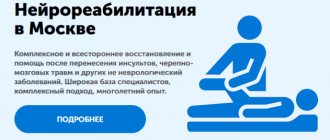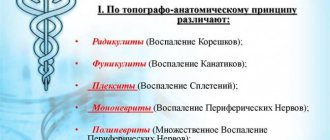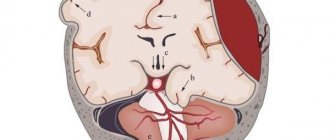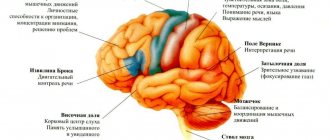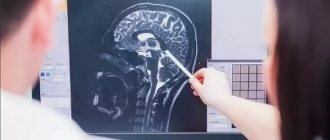Mechanical damage to the human skull along with its contents, which is manifested by established neurological symptoms, is called traumatic brain injury. Timely first aid for traumatic brain injuries helps save the life and many functions of the victim’s body, so it is extremely important to know all the basics of behavior in such a situation.
Main causes and types of injuries in the skull area
The pathologies under study can arise as a result of many factors, for example, during road traffic accidents, human falls from a height, at work and at home, during active sports.
Content:
- Main causes and types of injuries in the skull area
- Clinical course of the pathology
- First aid
The main types of traumatic brain injuries include closed, open and penetrating injuries to the head. The closed type of such injuries include those in which the aponeurosis remains without damage, but there are injuries or bruises to the head in the soft tissue section. Open craniocerebral injuries are characterized by damage to the aponeurosis and integrity of the skin on the head. Experts consider penetrating injuries to be those that result in disruption of the integrity of the dura mater of the brain.
Traumatic brain injuries. Causes. Symptoms Diagnostics. First aid
home
Traumatic brain injuries are a major socio-medical problem, since their prevalence remains quite high, while injuries most often occur in people of working age, and its consequences can persist throughout life, leading to loss of ability to work and huge economic costs for the rehabilitation of the patient.
In this regard, it is necessary to understand that already the first signs of TBI, and we are talking, first of all, about loss of consciousness, require seeking specialized medical help. And the sooner help is provided and full treatment is carried out, the more effective it will be, and the less likely there will be to develop serious and irreversible consequences of the injury.
Our ambulance is one of the most mobile, and the qualifications of our specialists are beyond doubt. Therefore, we advise you to immediately call our ambulance team if you suspect that a person has suffered a traumatic brain injury before your eyes. And the sooner you make the call, the more effective the help will be.
Causes of traumatic brain injury
In fact, the causes of traumatic brain injury can be very diverse, but the most common are:
- caused by traffic accidents
- may be caused by work-related injuries
- obtained at home
- are the result of sports injuries.
At the same time, the cause of the traumatic brain injury also influences the course of the disease. Thus, when you hit the head with a heavy object or fall, focal lesions or hematomas often occur in the epidural or subdural space, while in road traffic accidents (emergency braking), diffuse brain damage occurs.
In any case, a patient with a traumatic brain injury requires emergency hospitalization , and if not even for treatment (for a mild concussion), then to perform a full examination and exclude the presence of more severe injuries.
Therefore, an ambulance must be called immediately, because only in this case will hospitalization be carried out as soon as possible and in a specialized department. An attempt to independently transport a patient to a hospital often leads to a significant loss of time until the proper department is found, the scope of necessary research is determined, and so on. And lost time means a high probability of developing complications and subsequent disability of the patient.
If a person suffers a severe traumatic brain injury in a motor vehicle accident or for any other reason, resuscitative transport may be required if the patient is unconscious and breathing and cardiac function are impaired. In this case, our paid ambulance will become indispensable, since we have everything necessary to quickly transport the patient to the hospital, as well as provide emergency assistance at the transportation stage.
Symptoms of traumatic brain injury
It cannot be said that traumatic brain injury is manifested by strictly defined symptoms, since the clinical picture depends on the active factor, its strength, the depth of brain damage, the presence of focal changes, and so on.
With closed craniocerebral injuries, the skin and bones of the cranial vault may not be affected, so at first glance there may be no signs of injury, but symptoms of TBI are always observed, such as:
- loss of consciousness for at least a few seconds
- presence of nausea or vomiting
- retrograde amnesia (a person does not remember the events that immediately preceded the injury).
With an open craniocerebral injury, in addition to loss of consciousness, damage to the skin and bones of the skull is observed, while if the dura mater remains intact, then the injury is considered non-penetrating, and if damaged, then penetrating. When the bones of the skull are fractured, external signs of skin damage may not be immediately visible, but a characteristic symptom is the leakage of cerebrospinal fluid (a clear liquid) from the ear canal or nose, and blood may also leak. Also characteristic is the so-called “glasses symptom” - hemorrhages under both eyes.
With diffuse brain damage, general cerebral symptoms will occur, which boil down to:
- severe headache
- possible photophobia
- tinnitus, loss of coordination of movements
- most often there is nausea, in some cases there may be vomiting, which does not bring relief.
If a focal lesion occurs, for example, a hematoma occurs, then the appearance of focal symptoms may be observed:
- paresis or paralysis in the limbs
- sensory disturbances
- facial nerve paresis
- the appearance of drooping eyelids, differences in pupil size, and so on.
The main factor for diagnosis is still the presence of a history of trauma. Therefore, if you witnessed a person fall or get injured in another way, you saw that the person then lost consciousness, then other symptoms are no longer needed to try to call a paid ambulance as soon as possible, in order to provide first aid as quickly as possible and deliver the person to a specialized medical institution.
Please note that sometimes a person can fall due to a brain accident, for example, a stroke, as well as during an epileptic seizure, and so on. In this case, the blow may be such that, against the background of already existing changes, an injury will be sustained. Therefore, the injury may be of secondary origin, but in any case, the patient requires the fastest possible care and hospitalization in order to increase the chances of survival and full recovery.
Diagnostic approaches for TBI
Of course, the main method for diagnosing TBI is an examination by a specialist, since after the first examination by a doctor and clarification of the medical history, one can conclude that there is a TBI or other pathology. In addition, the first examination suggests the presence of a certain type of traumatic brain injury, as well as the degree of its severity.
It is after this that the range of further examinations is determined. Therefore, you need to call a doctor to a patient with a suspected traumatic brain injury as soon as possible. And only a paid ambulance in this case is an adequate solution, since it not only arrives on site in the shortest possible time, but also has all the capabilities to carry out full resuscitation measures that a patient with a traumatic brain injury may need.
Transportation of the victim should be carried out as soon as possible and only to specialized clinics where there are opportunities to conduct research such as:
- radiography of the skull bones
- computed tomography of the brain
- lumbar puncture
— electroencephalography.
Please note that traumatic brain injury can lead to the development of cerebral edema, which requires emergency treatment, but lumbar puncture, which can be fatal, is strictly contraindicated. That is why it is important to take the patient to a specialized clinic and perform the full range of necessary examinations in order to determine emergency measures.
Treatment of traumatic brain injury
Treatment of traumatic brain injury is complex and lengthy, and in many cases also very controversial. Only the mildest concussions do not require specific treatment, while some traumatic brain injuries cannot be treated without surgical intervention.
In any case, the amount of necessary treatment is determined by the doctor after conducting appropriate studies. At the first stages, the two most important tasks are:
— provision of emergency first aid
- emergency hospitalization.
First aid is to:
- place the patient on his back
- turn your head to the side
- stick out your tongue to prevent aspiration of vomit
- unfasten the collar and provide fresh air if the patient is not outside
- try to stop bleeding, if any.
- in the presence of
- administer a painkiller
- Call an ambulance as quickly as possible.
Call our paid ambulance , be confident in the mobility of our teams and the high competence of specialists who have already saved hundreds of lives!
Clinical course of the pathology
More often than others, with traumatic brain injuries, a concussion occurs without macrostructural lesions. Brain damage at the cellular level is reversible and treatable. The main symptoms of a concussion are loss of consciousness for a short time, nausea and vomiting, dizziness, headaches, double vision, sweating, memory loss. From a neurological point of view, there is a violation of symmetry in tendon reflexes, small-scale nystagmus, which under normal conditions disappears a week after the injury. If the victim undergoes a computer or magnetic resonance imaging scan, they will not reveal any pathologies.
With traumatic brain injuries, brain contusion can occur. This pathology leads to hemorrhages and destruction (gross macrostructural disorders) in the brain, accompanied by subarachnoid hemorrhage. Often a brain contusion is accompanied by a fracture of the skull bones. All this together can lead to swelling of the brain.
Manifestations of brain contusion by severity:
- Mild degree - the patient’s loss of consciousness can last up to 20 minutes, after which dizziness, vomiting and nausea, headaches, anterograde or retrograde amnesia occur. Vital functions remain unchanged; cardiovascular changes in the form of hypertension or bradycardia may occur. Neurological symptoms include pyramidal insufficiency, clonic nystagmus, and slight anisocoria.
- In the middle stage, the patient’s unconscious state lasts for several hours, after which severe memory loss occurs, repeated vomiting occurs, and mental health is impaired. Vital functions are impaired, persistent bradycardia, tachypnea with preservation of airway patency, hypertension. From a neurological point of view, nystagmus, imbalance in tendon reflexes and muscle tone, and various meningeal signs are observed. Focal manifestations in the form of ocular and pupillary disorders, changes in speech, and paresis of the limbs are also obvious.
- In severe cases, the patient falls into a coma, which, if not fatal, can last several weeks. Severe violations of vital functions pose a threat to life. The movements of the eyeballs are floating, the rhythm and frequency of breathing are disturbed, bilateral miosis or mydriasis, and convulsions occur. With such traumatic brain injuries, there are fractures of the skull bones in combination with massive subarachnoid hemorrhage.
Compression of the brain substance may occur due to intracranial hematomas that form above or below the soft membrane.
Clinically, compression can manifest itself in the same way as a bruise, but it has a very dangerous consequence. After the victim returns to consciousness, he usually feels better, but this does not last long, until the intracranial hematoma grows in size and begins to compress the brain. After this, the person falls into a coma again, and the prognosis for this state is rarely satisfactory. The functioning of the respiratory and vascular centers is disrupted.
Brain concussion
A concussion is considered a fairly mild form of traumatic brain injury with reversible consequences.
Symptoms of a concussion can appear within the first day after a head injury.
It is important to pay attention to the following possible signs of a concussion:
- dizziness and headache;
- nausea, vomiting (may occur repeatedly);
- fainting (depending on the degree of damage, loss of consciousness can be short-term or long-lasting);
- insomnia;
- violation of orientation in space and time;
- noise in ears;
- flushes of blood to the face;
- increased sweating.
In older people and children, a concussion is possible without loss of consciousness, but older patients may experience disturbances in orientation in space and time.
Diagnosis and treatment of concussion
For the diagnosis of all types of traumatic brain injuries, the most informative are x-rays and magnetic resonance imaging. This allows you to exclude a fracture of the skull bones.
When a concussion is treated, the prognosis is usually favorable.
Drug treatment is aimed at improving the condition of the brain, relieving pain, eliminating dizziness, insomnia and anxiety. Therefore, when treating a concussion, the patient is given a course of metabolic and vascular therapy.
Diagnostics
When a patient with a traumatic brain injury is admitted to the intensive care unit, the following measures must be taken:
- Examination of the victim’s body, during which abrasions, bruises, joint deformities, changes in the shape of the abdomen and chest, bleeding and/or liquor leakage from the ears and nose, bleeding from the rectum and/or urethra, and a specific odor from the mouth are detected or excluded.
- Comprehensive x-ray examination: skull in 2 projections, cervical, thoracic and lumbar spine, chest, pelvic bones, upper and lower extremities.
- Ultrasound of the chest, ultrasound of the abdominal cavity and retroperitoneal space.
- Laboratory tests: general clinical analysis of blood and urine, biochemical blood test (creatinine, urea, bilirubin, etc.), blood sugar, electrolytes. These laboratory tests must be carried out in the future, daily.
- ECG (three standard and six chest leads).
- Testing urine and blood for alcohol content. If necessary, consult a toxicologist.
- Consultations with a neurosurgeon, surgeon, traumatologist.
A mandatory method of examining victims with traumatic brain injury is computed tomography. Relative contraindications to its implementation may include hemorrhagic or traumatic shock, as well as unstable hemodynamics. Using CT, the pathological focus and its location, the number and volume of hyper- and hypodense zones, the position and degree of displacement of the midline structures of the brain, the condition and degree of damage to the brain and skull are determined.
If meningitis is suspected, a lumbar puncture and dynamic examination of the cerebrospinal fluid are indicated, which allows monitoring changes in the inflammatory nature of its composition.
A neurological examination of a patient with a traumatic brain injury should be performed every 4 hours. To determine the degree of consciousness impairment, the Glasgow Coma Scale is used (state of speech, response to pain and ability to open/close eyes). In addition, the level of focal, oculomotor, pupillary and bulbar disorders is determined.
First aid for head injury
In case of a soft tissue bruise, you need to put a bag of snow, ice or water on the victim's head. You can also moisten several layers of gauze with cold water, squeeze well and apply to the bruised area. The edges of the wound should be treated with a 1% alcohol solution of iodine or a 5% alcohol solution of brilliant green and cover it with a sterile gauze bandage; bleeding is stopped with a pressure bandage. If there are signs of fractures of the cranial vault, then the bandage is applied very carefully. Pieces of bones, metal, and fragments protruding from the wound are not removed to avoid bleeding. If brain matter is visible in the wound, do not press it down; several sterile napkins are placed on the wound, and a roller is placed around them, which is rolled up from cotton wool and gauze like a donut. A bandage should be applied on top. If the base of the skull is fractured, the victim is laid horizontally, with the head turned to the side. In case of a fracture of the lower jaw, stop the bleeding using tampons and a sterile bandage; bleeding can also be stopped by pressing the artery with a finger to the angle of the lower jaw. You can also bandage the lower jaw to the head with a sling bandage. The victim's mouth must be cleared of knocked out teeth, vomit and blood clots. If there are no wounds, apply cold to the damaged area. If necessary, perform cardiopulmonary resuscitation.
The life of a victim with a head injury depends on who is nearby at the time of the incident: a person can be saved only when the injury is recognized in a timely manner and qualified first aid is provided. After providing first aid, be sure to call an ambulance.
Causes
According to the genesis and mechanism of occurrence, TBI can be primary (the impact of traumatic mechanical energy on the brain is not preceded by any cerebral or extracerebral catastrophe) and secondary (the impact of traumatic mechanical energy on the brain is preceded by a cerebral or extracerebral catastrophe). TBI in the same patient can occur for the first time or repeatedly (twice, three times).
- Primary lesions are focal contusions and crushes of the brain, diffuse axonal damage, intracranial hematomas, brainstem ruptures, multiple intracerebral hemorrhages resulting from mechanical head trauma.
- Secondary lesions arise as a result of the action of secondary intracranial factors (delayed hematomas, disturbances of liquor and hemocirculation due to intraventricular or subarachnoid hemorrhage, cerebral edema, hyperemia, etc.) or secondary extracranial factors (arterial hypertension, hypercapnia, hypoxemia, anemia, etc.)
Brain contusion
Compared to a concussion, a brain contusion is a more serious injury that requires urgent treatment. With this type of TBI, small vessels of the brain are affected, hemorrhage occurs, and cerebrospinal fluid (cerebrospinal fluid) may leak.
The injury may be accompanied by compression of soft tissues or occur without it. The method of treating a brain contusion depends on this.
The main symptoms of a brain contusion without compression :
- loss of consciousness (or coma);
- frequent vomiting;
- tachycardia and arrhythmia;
- decreased muscle function in the arms and legs (paresis) and loss of coordination;
- high blood pressure;
- the appearance of blood in the cerebrospinal fluid;
- prolonged severe headaches;
- vestibular dysfunction;
- loss of memory for immediate events.
Compression of the brain may occur during the head injury itself or some time later as a result of the occurrence of an intracranial hematoma.
Hematomas can be acute, subacute and chronic. If in the first case the patient’s condition begins to rapidly deteriorate, then with subacute and chronic hematoma the inflammatory process can last for months.
When the brain is compressed by a hematoma, the following clinical signs :
- convulsions;
- increased intracranial pressure;
- the appearance of delusions and hallucinations;
- weakening of abdominal and tendon reflexes;
- paresis or paralysis of the limbs;
- damage to the optic nerves.
According to severity they are distinguished:
- Mild TBI: characterized by a concussion and mild brain contusion;
- Moderate TBI: characterized by moderate brain contusion; In this case, the following are possible: fracture of the vault and base of the skull, traumatic subarachnoid hemorrhage, epileptic seizures;
- Severe TBI: characterized by severe brain contusion, brain compression, severe axonal damage to the brain; Possible fractures of the vault and base of the skull, epileptic seizures, severe brainstem and diencephalic disorders.

